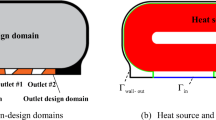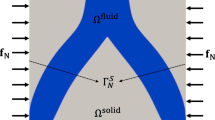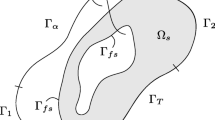Abstract
With the increasing development of topology optimization theory in thermal-fluid problems, it has been widely applied in design problems of cooling structures. However, little researches have concurrently considered the design-dependent mechanical problems of optimized structures. This paper deals with porosity-based topology optimization of forced convection planar heat sinks considering out-of-plane design-dependent deformation problems. The optimization is performed on the middle cross-section and the mechanical behaviors of the upper cover plate are considered. Governing equations of fluid flow, heat transfer, and structural mechanic fields are constructed. Particularly, to concurrently model design-dependent loads and boundary conditions, a spring term with design-dependent stiffnesses and a design-dependent pressure term are introduced into the out-of-plane mechanical model. Numerical examples in fluid-mechanical decoupled and weakly-coupled cases are given to demonstrate the validity and potential of the present approach. Additionally, the presented scheme is also evaluated in cases considering the global mechanical behavior and cases considering the local mechanical behavior. Comparisons and verifications show that the proposed approach is effective in yielding planar heat sinks with optimized heat transfer capabilities and well-controlled out-of-plane mechanical behaviors.













Similar content being viewed by others
References
Garimella SV, Fleischer AS, Murthy JY et al (2008) Thermal challenges in next-generation electronic systems. IEEE Trans Compon Packag Technol. https://doi.org/10.1109/TCAPT.2008.2001197
Ben Sik Ali A, Kriaa W, Mhiri H, Bournot P (2018) Analysis of the influence of cooling hole arrangement on the protection of a gas turbine combustor liner. Meccanica 53:2257–2271. https://doi.org/10.1007/s11012-018-0824-4
Zeng S, Sun Q, Lee PS (2020) Thermohydraulic analysis of a new fin pattern derived from topology optimized heat sink structures. Int J Heat Mass Transf. https://doi.org/10.1016/j.ijheatmasstransfer.2019.118909
Li H, Ding X, Meng F et al (2019) Optimal design and thermal modelling for liquid-cooled heat sink based on multi-objective topology optimization: an experimental and numerical study. Int J Heat Mass Transf. https://doi.org/10.1016/j.ijheatmasstransfer.2019.118638
Christen D, Stojadinovic M, Biela J (2017) Energy efficient heat sink design: natural versus forced convection cooling. IEEE Trans Power Electron 32(11):8693–8704. https://doi.org/10.1109/TPEL.2016.2640454
Ghani IA, Sidik NAC, Kamaruzaman N (2017) Hydrothermal performance of microchannel heat sink: the effect of channel design. Int J Heat Mass Transf 107:21–44
Sui Y, Teo CJ, Lee PS et al (2010) Fluid flow and heat transfer in wavy microchannels. Int J Heat Mass Transf. https://doi.org/10.1016/j.ijheatmasstransfer.2010.02.022
Geyer PE, Fletcher DF, Haynes BS (2007) Laminar flow and heat transfer in a periodic trapezoidal channel with semi-circular cross-section. Int J Heat Mass Transf. https://doi.org/10.1016/j.ijheatmasstransfer.2007.01.050
Xia C, Fu J, Lai J et al (2015) Conjugate heat transfer in fractal tree-like channels network heat sink for high-speed motorized spindle cooling. Appl Therm Eng. https://doi.org/10.1016/j.applthermaleng.2015.07.024
Hong DP, Lee DY, Byon C (2014) Least material optimization of natural-convective heat sinks. Int J Precis Eng Manuf. https://doi.org/10.1007/s12541-014-0481-z
Wang W, Tian X, Qian S et al (2020) Secondary shape optimization of topological boundary of cold plate channels. Meccanica. https://doi.org/10.1007/s11012-019-01108-x
Zhao X, Zhou M, Sigmund O, Andreasen CS (2018) A “poor man’s approach” to topology optimization of cooling channels based on a Darcy flow model. Int J Heat Mass Transf. https://doi.org/10.1016/j.ijheatmasstransfer.2017.09.090
Ahmed HE, Ahmed MI (2015) Optimum thermal design of triangular, trapezoidal and rectangular grooved microchannel heat sinks. Int Commun Heat Mass Transf. https://doi.org/10.1016/j.icheatmasstransfer.2015.05.009
Bendsøe MP, Sigmund O (2003) Topology optimization: theory, methods, and applications, engineering. Springer, Berlin
Joo Y, Lee I, Kim SJ (2018) Efficient three-dimensional topology optimization of heat sinks in natural convection using the shape-dependent convection model. Int J Heat Mass Transf. https://doi.org/10.1016/j.ijheatmasstransfer.2018.08.009
Dede E (2009) Multiphysics topology optimization of heat transfer and fluid flow systems. In: Proceedings of COMSOL users conference. Retrieved from cds.comsol.com/access/dl/papers/6282/Dede.pdf
Yoon GH (2010) Topological design of heat dissipating structure with forced convective heat transfer. J Mech Sci Technol. https://doi.org/10.1007/s12206-010-0328-1
Dilgen SB, Dilgen CB, Fuhrman DR et al (2018) Density based topology optimization of turbulent flow heat transfer systems. Struct Multidiscip Optim. https://doi.org/10.1007/s00158-018-1967-6
Yaji K, Ogino M, Chen C, Fujita K (2018) Large-scale topology optimization incorporating local-in-time adjoint-based method for unsteady thermal-fluid problem. Struct Multidiscip Optim 58(2):817–822. https://doi.org/10.1007/s00158-018-1922-6
Lv Y, Liu S (2018) Topology optimization and heat dissipation performance analysis of a micro-channel heat sink. Meccanica. https://doi.org/10.1007/s11012-018-0918-z
Van Oevelen T, Baelmans M (2014) Application of topology optimization in a conjugate heat transfer problem. In: OPT-i 2014—1st international conference on engineering and applied sciences optimization, proceedings
Yaji K, Yamada T, Yoshino M et al (2016) Topology optimization in thermal-fluid flow using the lattice Boltzmann method. J Comput Phys. https://doi.org/10.1016/j.jcp.2015.12.008
Yoon GH (2012) Topological layout design of electro-fluid-thermal-compliant actuator. Comput Methods Appl Mech Eng. https://doi.org/10.1016/j.cma.2011.11.005
Zhao X, Zhou M, Liu Y et al (2019) Topology optimization of channel cooling structures considering thermomechanical behavior. Struct Multidiscip Optim. https://doi.org/10.1007/s00158-018-2087-z
Li T, Wu T, Ding X et al (2017) Design of an internally cooled turning tool based on topology optimization and CFD simulation. Int J Adv Manuf Technol. https://doi.org/10.1007/s00170-016-9804-9
Kim SH, Ahn BH, Ha JM et al (2016) Structural and vibration analysis considering the flow velocity of the heat exchanger. Int J Precis Eng Manuf. https://doi.org/10.1007/s12541-016-0090-0
Kim NH, Cho JR, Ra YJ (2018) Structural integrity analysis and evaluation of cooled cooling air heat exchanger for aero engine. Int J Precis Eng Manuf. https://doi.org/10.1007/s12541-018-0064-5
Kumar P, Frouws JS, Langelaar M (2020) Topology optimization of fluidic pressure-loaded structures and compliant mechanisms using the Darcy method. Struct Multidiscip Optim. https://doi.org/10.1007/s00158-019-02442-0
Deaton JD, Grandhi RV (2014) A survey of structural and multidisciplinary continuum topology optimization: post 2000. Multidiscip Optim Struct 1:1. https://doi.org/10.1007/s00158-013-0956-z
Olesen LH, Okkels F, Bruus H (2006) A high-level programming-language implementation of topology optimization applied to steady-state Navier–Stokes flow. Int J Numer Methods Eng. https://doi.org/10.1002/nme.1468
Stolpe M, Svanberg K (2001) An alternative interpolation scheme for minimum compliance topology optimization. Struct Multidiscip Optim 22:116–124
Lazarov BS, Sigmund O (2011) Filters in topology optimization based on Helmholtz-type differential equations. Int J Numer Methods Eng. https://doi.org/10.1002/nme.3072
Wang F, Lazarov BS, Sigmund O (2011) On projection methods, convergence and robust formulations in topology optimization. Struct Multidiscip Optim. https://doi.org/10.1007/s00158-010-0602-y
Svanberg K (1987) The method of moving asymptotes—a new method for structural optimization. Int J Numer Methods Eng. https://doi.org/10.1002/nme.1620240207
Alexandersen J, Sigmund O, Aage N (2016) Large scale three-dimensional topology optimisation of heat sinks cooled by natural convection. Int J Heat Mass Transf. https://doi.org/10.1016/j.ijheatmasstransfer.2016.05.013
Yan S, Wang F, Hong J, Sigmund O (2019) Topology optimization of microchannel heat sinks using a two-layer model. Int J Heat Mass Transf. https://doi.org/10.1016/j.ijheatmasstransfer.2019.118462
Zeng S, Kanargi B, Lee PS (2018) Experimental and numerical investigation of a mini channel forced air heat sink designed by topology optimization. Int J Heat Mass Transf. https://doi.org/10.1016/j.ijheatmasstransfer.2018.01.039
Zhao J, Zhang M, Zhu Y et al (2020) Concurrent optimization of the internal flow channel, inlets, and outlets in forced convection heat sinks. Struct Multidiscip Optim. https://doi.org/10.1007/s00158-020-02670-9
Haertel JHK, Engelbrecht K, Lazarov BS, Sigmund O (2018) Topology optimization of a pseudo 3D thermofluid heat sink model. Int J Heat Mass Transf. https://doi.org/10.1016/j.ijheatmasstransfer.2018.01.078
Qiu GY, Li XS (2010) A note on the derivation of global stress constraints. Struct Multidiscip Optim. https://doi.org/10.1007/s00158-009-0397-x
París J, Navarrina F, Colominas I, Casteleiro M (2009) Topology optimization of continuum structures with local and global stress constraints. Struct Multidiscip Optim. https://doi.org/10.1007/s00158-008-0336-2
Acknowledgements
This work was supported in part by the National Natural Science Foundation of China under Grant 51677104. The author thanks Prof. Krister Svanberg for use of the MMA optimizer.
Author information
Authors and Affiliations
Corresponding author
Ethics declarations
Conflict of interest
The authors declare that they have no conflict of interest.
Additional information
Publisher's Note
Springer Nature remains neutral with regard to jurisdictional claims in published maps and institutional affiliations.
Rights and permissions
About this article
Cite this article
Zhao, J., Zhang, M., Zhu, Y. et al. Topology optimization of planar heat sinks considering out-of-plane design-dependent deformation problems. Meccanica 56, 1693–1706 (2021). https://doi.org/10.1007/s11012-021-01337-z
Received:
Accepted:
Published:
Issue Date:
DOI: https://doi.org/10.1007/s11012-021-01337-z




